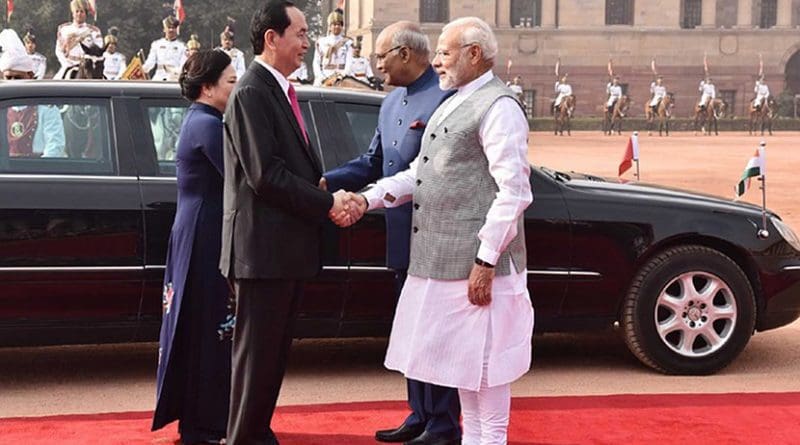Vietnam’s President Tran Dai Quang Visit To India: A Leg Up For Strategic Defence Partnership To Counterweigh China – Analysis
Visit of Vietnamese President Tran Dai Quang to India came at a time when momentum of bilateral ties, predominated by defence and ASEAN leader’s penchant for closer ties with India, reflected by their visits in Republic Day celebration in January, hogged the limelight.
Close on the visit of Vietnam’s Prime Minister Nguyen Xuan in Republic Day celebration, along with other nine leaders of ASEAN, the visit of Vietnam’s President Tran Dai Quang to India in March (4-6) should be viewed not merely from the angle of bilateral economic engagement, but also should be seen both countries’ assertiveness to dismantle China’s aggressiveness in South China sea and South East Asia. This visit, back-to-back with the visit of Prime Minister Narendra Modi to Vietnam in September 2016, will mark a milestone for a strong diplomatic relation between the two countries, particularly when China is flexing its political and military clout in South China sea, after losing arbitration in UNCLOS.
Incidentally, both Vietnam and India are the victims of Chinese aggression in South China Sea. The bilateral partnership ejects a far-reaching importance of India’s role in South East Asia under the umbrella of Modi’s Act Asia policy.
The paradox behind the Vietnam’s stronger defence ties with India is that an inverse relation is underplaying between the two countries in terms of political and economic relation. Vietnam is ruled by Communist regime and China is the second biggest trading partner of Vietnam. Against these, India is the largest democratic country in the world and the tenth biggest trading partner of Vietnam. The fact of the matter is that despite these, Vietnam is closer to India in terms of people-to-people relation. India is much above China in the Vietnamese choices.
According to Pew Research Center, of its Global Attitude survey , 66 percent of Vietnamese have favorable opinion about India against 19 percent for China. Further, 56 percent of Vietnamese have confidence in Modi’s leadership for driving the world affairs in right direction, compared to 20 percent in favour of Chinese President Xi Jinping
The survey also found that a higher proportion of Vietnamese, 60 percent, were much concerned about territorial disputes with China.
The turning point for closer ties was noted when Prime Minister Narendra Modi visited Vietnam in September 2016 – the first visit by an Indian Prime Minister after 15 years. Incidentally, this was also the same year Vietnam elected its new President Tran Dai Quang and China defied the arbitration ruling. The visit proved a path breaking achievement to refurbish the relation when India – once known as global leader for its non-alignment stand — offered defence cooperation and elevated the relation from strategic partnership to Comprehensive Strategic Partnership.
India committed US $ 500 million line of credit for procurement of defence equipment during Modi’s visit to Vietnam in 2016. Apart this, India has been training Vietnamese military in operating its Russian-built Kilo-class submarine and SU-30 fighter jets. The two sides signed MOU for Coast Guard – Guard collaboration. The sale of Brahmos missiles to Vietnam are part of ongoing negotiations to strengthen defence cooperation.
Why is India the victim of South China Sea stir? Half of India’s international trade passes through South China sea water. Besides, China’s defiance, which haunts maritime right of Vietnam in its Exclusive Economic Zone (EEZ) in the sea, negated India’s crude oil exploration. In 2006, ONGC of India was awarded two oil blocks in Vietnam territorial water. One of them was relinquished by ONGC. The remaining Block 128 got entangled with the dispute , when Chinese company, China Off-shore National Company ( CNOOC) invited global bids for nine blocks, which are located in the Vietnam EEZ. Of these, two oil blocks overlap half of ONGC’s BLOCK 128.
In 2014, dispute aroused when Chinese oil rig company conducted oil drilling inside the Vietnam‘s EEZ. At this stage, India was at loggerheads with its off-shore oil drilling operation in Vietnam territorial water. Country-wide anti-China protest raged Vietnamese , resulting 21 deaths in the country. Since then a bitter relation erupted between Hanoi and Beijing.
Modi’s visit to Vietnam after the UN arbitration ruling was a shot in the arm for Vietnam. It gave a mental boost for the Vietnamese to make their voices stronger against Chinese bully in South China sea. It sent signal of its concerns through mustering the support of powerful countries and India was one of them. To this end, India’s commitment for line of credit for procurement of defence equipment and implementation of India- Vietnam Defence Relations of May 2015, underpinned India’s bigger role in South East Asia, including South China sea.
The upgrading of the ten year old strategic partnership between India and Vietnam into Comprehensive Strategic partnership unleashed deeper meaning of all round cooperation between the two countries. The Joint Statement during the visit of Modi , which was assertive to built Plan for Action of Comprehensive Strategic Partnership and give reality in all areas of cooperation, caught the attentions of global strategists
India is among the ten trading partners of Vietnam.
Currently, the total trade between the two countries is about US $8 Billion. In terms of India’s global trade it is insignificant. It accounts for 2 percent only. Modi’s visit enhanced the target to US $ 15 Billion by 2020
In summing up, back to back visits of two important Vietnam politburo members to India within a period of two months will rejig the relationship between the two countries for culminating Act Asia policy and open a new chapter for joint counterweight against Chinese hegemony in South China sea.
(Views are personal)

